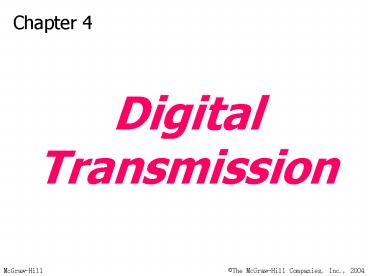Digital Transmission PowerPoint PPT Presentation
1 / 47
Title: Digital Transmission
1
Chapter 4
DigitalTransmission
2
4.1 Line Coding
Some Characteristics Line Coding Schemes Some
Other Schemes
3
Figure 4.1 Line coding
4
Figure 4.2 Signal level versus data level
5
Figure 4.3 DC component
6
Figure 4.4 Lack of synchronization
7
Example 3
In a digital transmission, the receiver clock is
0.1 percent faster than the sender clock. How
many extra bits per second does the receiver
receive if the data rate is 1 Kbps? How many if
the data rate is 1 Mbps?
Solution
At 1 Kbps 1000 bits sent ?1001 bits received?1
extra bps At 1 Mbps 1,000,000 bits sent
?1,001,000 bits received?1000 extra bps
8
Figure 4.5 Line coding schemes
9
Note
Unipolar encoding uses only one voltage level.
10
Figure 4.6 Unipolar encoding
11
Note
Polar encoding uses two voltage levels (positive
and negative).
12
Figure 4.7 Types of polar encoding
13
Note
In NRZ-L the level of the signal is dependent
upon the state of the bit.
14
Note
In NRZ-I the signal is inverted if a 1 is
encountered.
15
Figure 4.8 NRZ-L and NRZ-I encoding
16
Figure 4.9 RZ encoding
17
Note
A good encoded digital signal must contain a
provision for synchronization.
18
Figure 4.10 Manchester encoding
19
Note
In Manchester encoding, the transition at the
middle of the bit is used for both
synchronization and bit representation.
20
Figure 4.11 Differential Manchester encoding
21
Note
In differential Manchester encoding, the
transition at the middle of the bit is used only
for synchronization. The bit representation is
defined by the inversion or noninversion at the
beginning of the bit.
22
Note
In bipolar encoding, we use three levels
positive, zero, and negative.
23
Figure 4.12 Bipolar AMI encoding
24
Figure 4.13 2B1Q
25
Figure 4.14 MLT-3 signal
26
4.3 Sampling
Pulse Amplitude Modulation Pulse Code
Modulation Sampling Rate Nyquist Theorem How
Many Bits per Sample? Bit Rate
27
Figure 4.18 PAM
28
Note
Pulse amplitude modulation has some applications,
but it is not used by itself in data
communication. However, it is the first step in
another very popular conversion method called
pulse code modulation.
29
Figure 4.19 Quantized PAM signal
30
Figure 4.20 Quantizing by using sign and
magnitude
31
Figure 4.21 PCM
32
Figure 4.22 From analog signal to PCM digital
code
33
Note
According to the Nyquist theorem, the sampling
rate must be at least 2 times the highest
frequency.
34
Figure 4.23 Nyquist theorem
35
Example 4
What sampling rate is needed for a signal with a
bandwidth of 10,000 Hz (1000 to 11,000 Hz)?
Solution
The sampling rate must be twice the highest
frequency in the signal
Sampling rate 2 x (11,000) 22,000
samples/s
36
Example 5
A signal is sampled. Each sample requires at
least 12 levels of precision (0 to 5 and -0 to
-5). How many bits should be sent for each sample?
Solution
We need 4 bits 1 bit for the sign and 3 bits for
the value. A 3-bit value can represent 23 8
levels (000 to 111), which is more than what we
need. A 2-bit value is not enough since 22 4. A
4-bit value is too much because 24 16.
37
Example 6
We want to digitize the human voice. What is the
bit rate, assuming 8 bits per sample?
Solution
The human voice normally contains frequencies
from 0 to 4000 Hz. Sampling rate 4000 x 2
8000 samples/s Bit rate sampling rate x number
of bits per sample 8000 x 8 64,000 bps 64
Kbps
38
Note
Note that we can always change a band-pass signal
to a low-pass signal before sampling. In this
case, the sampling rate is twice the bandwidth.
39
4.4 Transmission Mode
Parallel Transmission Serial Transmission
40
Figure 4.24 Data transmission
41
Figure 4.25 Parallel transmission
42
Figure 4.26 Serial transmission
43
Note
In asynchronous transmission, we send 1 start bit
(0) at the beginning and 1 or more stop bits (1s)
at the end of each byte. There may be a gap
between each byte.
44
Note
Asynchronous here means asynchronous at the byte
level, but the bits are still synchronized
their durations are the same.
45
Figure 4.27 Asynchronous transmission
46
Note
In synchronous transmission, we send bits one
after another without start/stop bits or gaps.
It is the responsibility of the receiver to
group the bits.
47
Figure 4.28 Synchronous transmission

